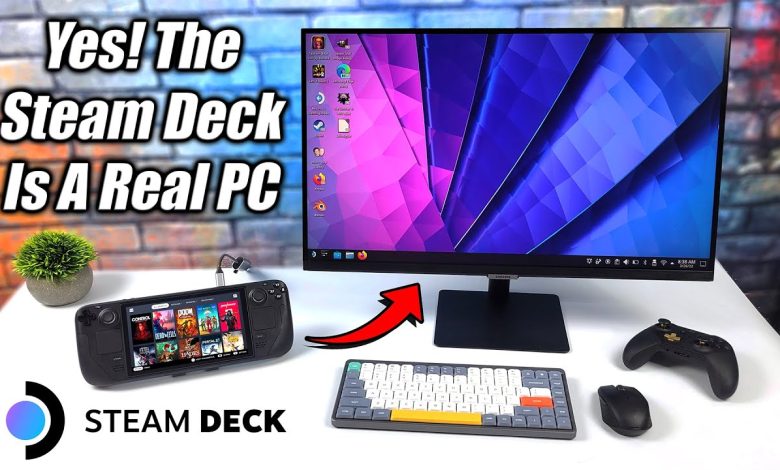How to use Steam Deck as a desktop PC

How to Use Steam Deck as a Desktop PC
The Steam Deck is a versatile handheld gaming console, but did you know it can also function as a desktop PC? With its powerful hardware and Linux-based SteamOS, the Steam Deck is capable of handling productivity tasks, web browsing, and media consumption. Here’s a step-by-step guide to turning your Steam Deck as a desktop PC.
What You Need
Before setting up the Steam Deck as a desktop PC, gather the following:
- Dock or USB-C Hub: A dock with HDMI/DisplayPort, USB ports, and Ethernet for connectivity.
- External Monitor: Any monitor or TV with an HDMI or DisplayPort input.
- Keyboard and Mouse: Wired or wireless peripherals.
- Power Adapter: The Steam Deck’s original charger or a compatible USB-C adapter.
- Optional Accessories: External storage, headphones, or a controller for additional functionality.

Step 1: Connect to a Dock or USB-C Hub
- Plug the Steam Deck into the Dock:
- Use the Steam Deck Dock or a third-party USB-C hub with power pass-through.
- Ensure the hub supports video output.
- Connect External Devices:
- Plug the monitor into the dock via HDMI or DisplayPort.
- Attach a keyboard, mouse, and any additional peripherals.
- Power the Setup:
- Connect the Steam Deck’s charger to the dock for stable power supply during use.
Step 2: Enable Desktop Mode
The Steam Deck runs SteamOS, which has a dedicated desktop mode.
Switching to Desktop Mode:
- Press the Steam Button to open the main menu.
- Scroll down and select Power.
- Choose Switch to Desktop Mode.
- The Steam Deck will restart in a Linux desktop environment (KDE Plasma).
Step 3: Configure the Desktop Environment
Once in desktop mode:
- Adjust Display Settings:
- Right-click on the desktop and choose Display Settings to configure resolution and orientation for the external monitor.
- Set Up Keyboard and Mouse:
- Test your peripherals to ensure they’re working. Use Bluetooth settings for wireless devices.
- Organize Shortcuts:
- Pin frequently used applications or games to the taskbar for easy access.
Step 4: Install Productivity Applications
The Steam Deck desktop mode supports Linux applications, making it suitable for work and browsing.
Install Apps via Discover Store:
- Open the Discover Software Center from the taskbar.
- Search for apps like:
- LibreOffice for document editing.
- Firefox or Chrome for web browsing.
- VLC Media Player for media playback.
- FileZilla for file transfers.
Install Third-Party Apps:
- Download and install software directly from the developers’ websites if not available in the store.
Step 5: Use External Storage
Expand storage with an external SSD or USB drive for large files:
- Plug the drive into the dock.
- Open the File Manager and locate your device.
- Format or mount the drive as needed for use.
Step 6: Optimize for Gaming
The Steam Deck’s desktop mode still supports Steam and other game platforms.
Run Steam Games:
- Open the Steam App on the desktop.
- Connect the monitor for a larger display experience.
- Pair a controller or use the keyboard and mouse for gameplay.
Install Non-Steam Games:
- Use Proton compatibility layers to run Windows games.
- Add non-Steam games to your library for easy access.
Step 7: Customize Your Setup
- Change the Theme:
- Go to System Settings > Appearance to customize the look of your desktop.
- Enable Updates:
- Regularly update SteamOS and installed software for optimal performance.
Step 8: Switch Back to Gaming Mode
When you’re ready to use the Steam Deck as a handheld console again:
- Click the Return to Gaming Mode icon on the desktop.
- The Steam Deck will reboot into its standard gaming interface.

Tips for an Enhanced Desktop Experience
- Use a Bluetooth speaker or headphones for better audio quality.
- Add a second monitor for multitasking.
- Consider a mechanical keyboard for a premium typing experience.
Conclusion
The Steam Deck’s flexibility makes it an excellent choice for a desktop PC setup. By connecting a dock, monitor, and peripherals, you can transform this handheld gaming device into a full-fledged workstation. Whether for productivity, media, or gaming, the Steam Deck is ready to handle it all.




